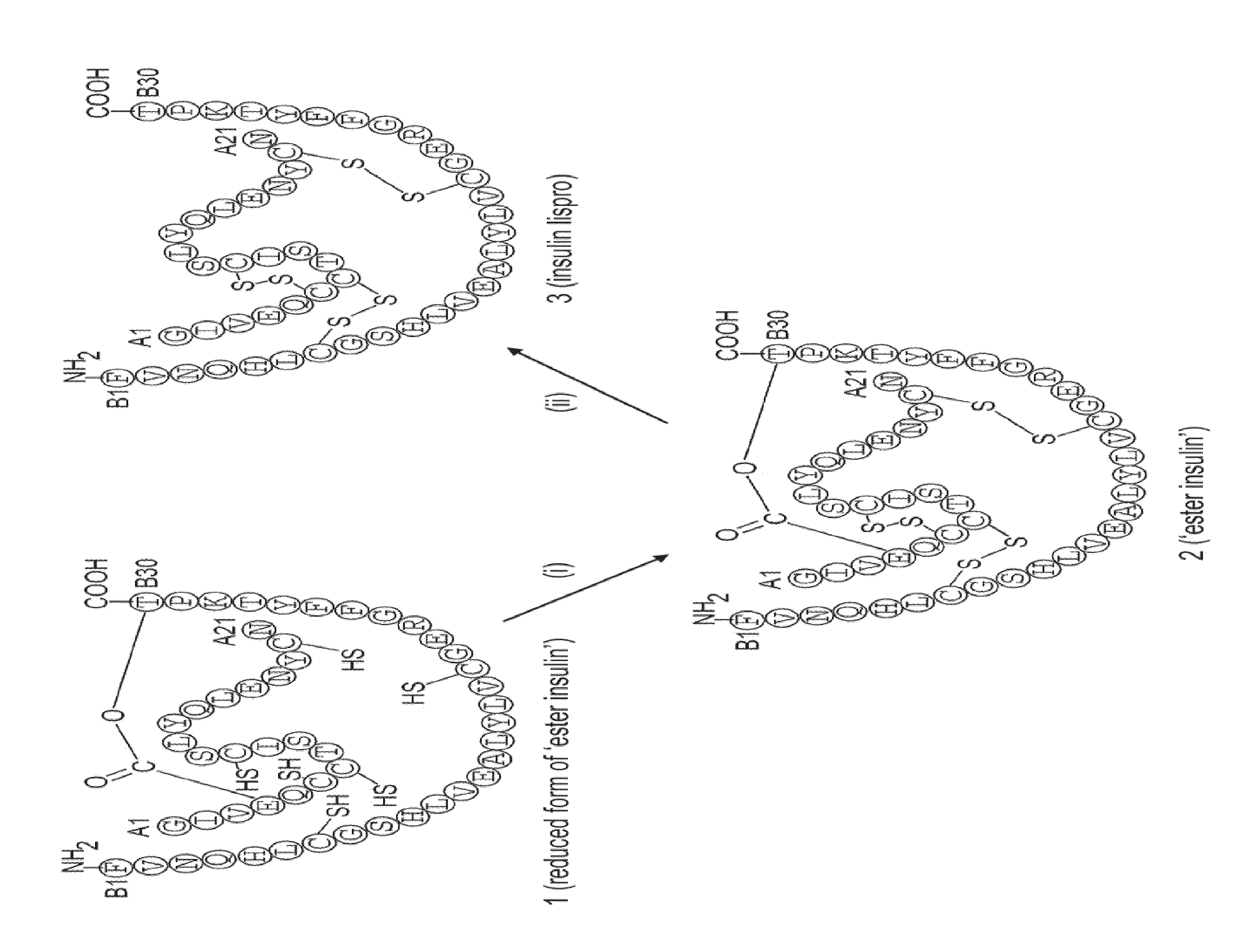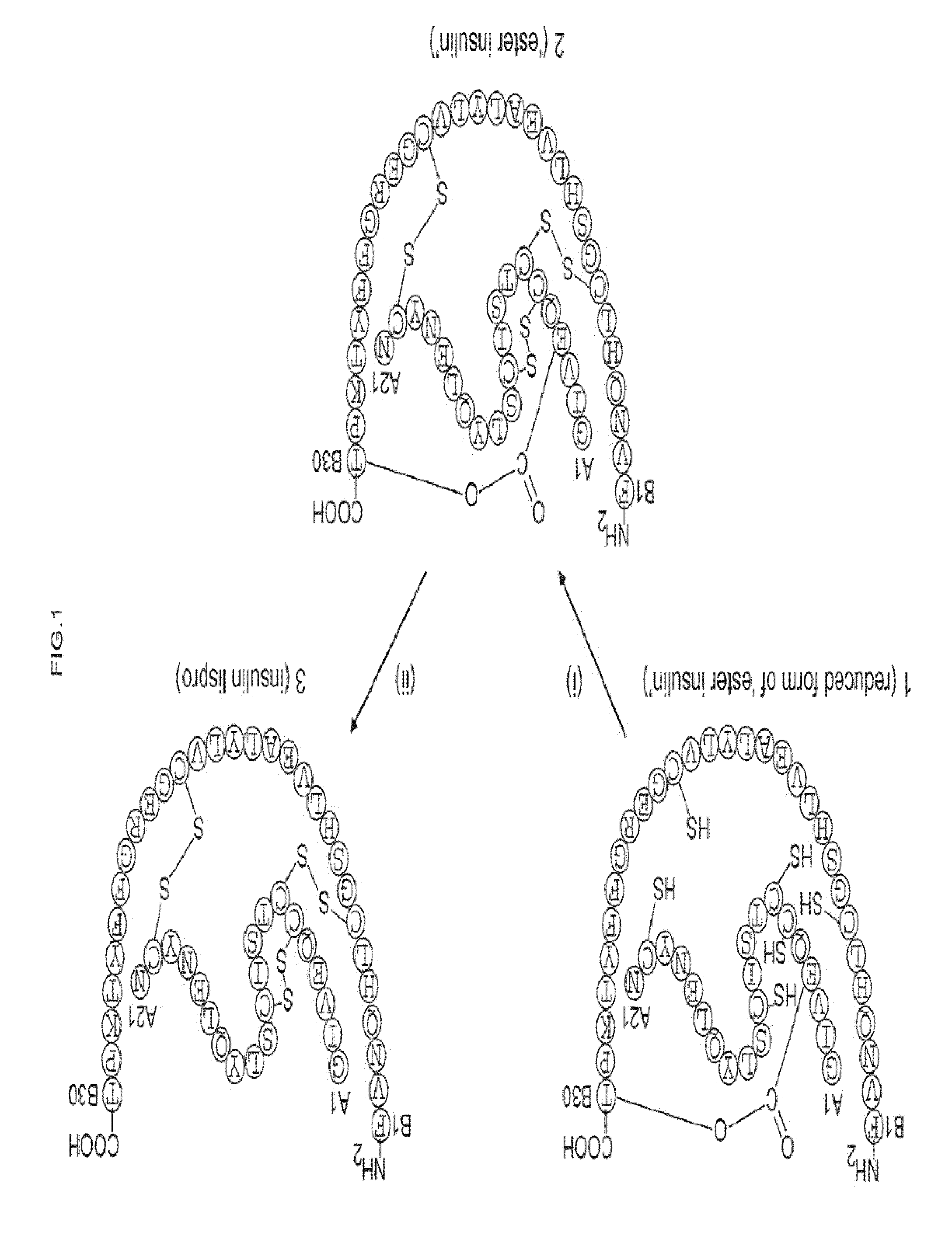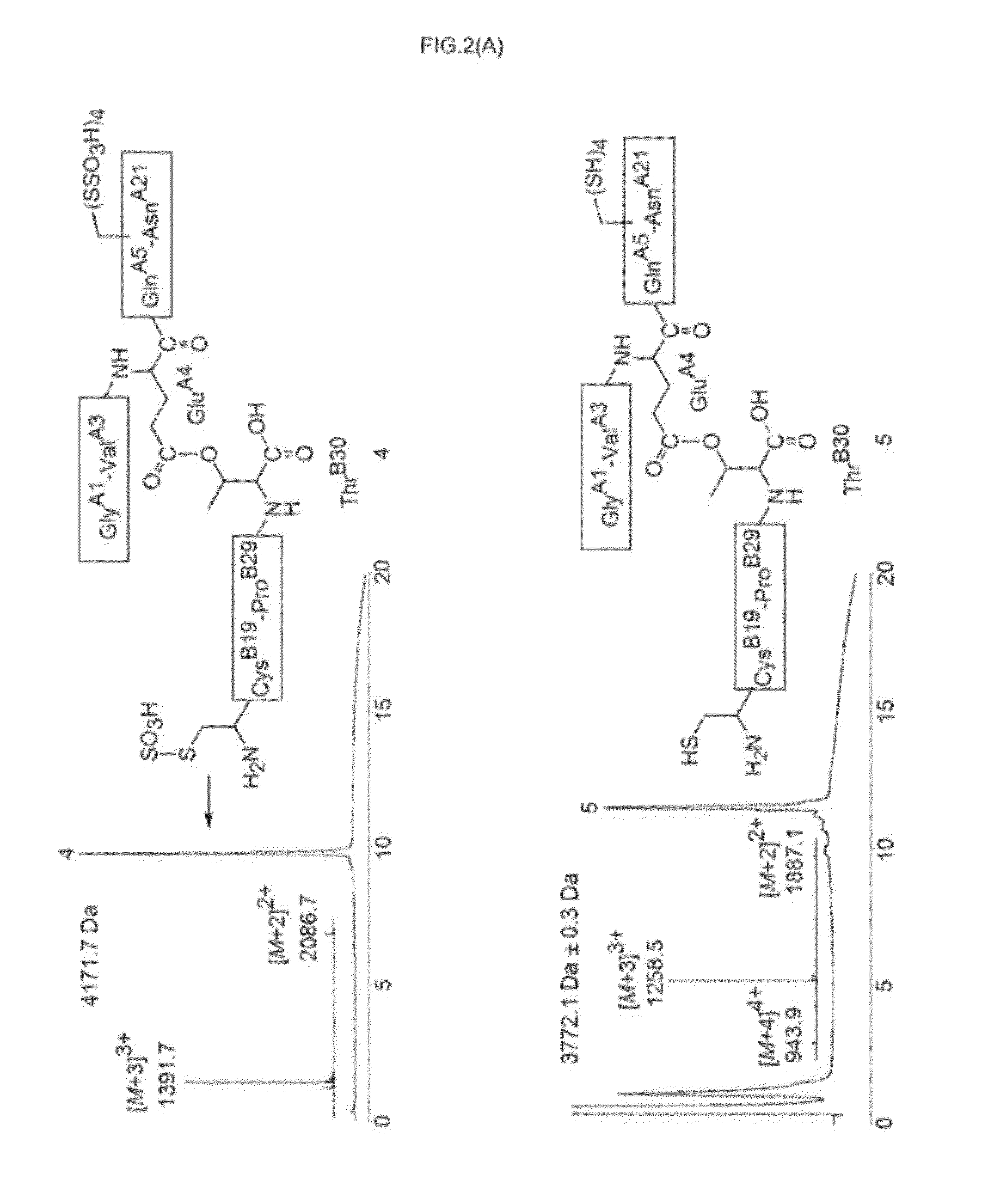Ester insulin
- Summary
- Abstract
- Description
- Claims
- Application Information
AI Technical Summary
Benefits of technology
Problems solved by technology
Method used
Image
Examples
example 1
General Methods
[0084]Boc-amino acids were obtained from Peptide Institute, Inc. Fmoc-amino acids, 2-(1H-benzotriazole-1-yl)-1,1,3,3-tetramethyluronium hexaftuorophosphate (HBTU) and 1-hydroxybenzotriazole (HOBt) were obtained from Peptides International, Inc. 1-Ethyl-3-(3-dimethyllaminopropyl)carbodiimide hydrochloride (EDC.HCl), N,N-dimethylaminopyridine (OMAP) and Fmoc-Glu-OBzl were from EMD Chemicals, Inc. 2-(1H-7-Azabenzotriazol-1-yl}-1,1,3,3-tetramethyluronium hexafluorophosphate (HATU) was from ChemPep, Inc. Trifluoroacetic acid (TFA) was from Halocarbon. All other chemical reagents were purchs8ed from Sigma-Aldrich or Fisher Scientific. Peptide compositions were evaluated by analytical reverse phase LC(-MS) using a gradient of 0.08% TFA in acetonitrile versus 0.1% TFA in water. For all the works reported in this paper, analytical HPLC was carried out as follows: C4 (2.1×50 mm) column using a linear gradient of 5-65% buffer a over 15 min at 40° C. with a flow rate of 0.5 mL mi...
example 2
Synthesis of Boc-Thr(Bzl)-OcHex
[0085]EDC.HCl (7.5 g, 40 mmol) was added to a stirring solution of Boc-Thr(Bzl)-OH (10 g, 32 mmol), cyclohexanol (5.0 mL, 48 mmol), and OMAP (0.66 g, 5.3 mmol) in OCM (75 mL) at 0° C. The mixture was warmed to room temperature (rt) over 30 min and stirred additionally overnight. After removal of the solvent in vacuo, the residue was dissolved in AcOEt, washed successively with 5% citric acid (3×), 5% NaHCO3 (3×) and saturated NaCl (3×), dried over MgSO4, and concentrated in vacuo. The resulting oil was purified by silica gel column chromatography (AcOE:hexane 1:8) to yield oily Boc-Thr(Bzl)-OcHex (12 g, 30 mmol, 95%). 1H NMR (CDCl3 400 MHz) 67.34-7.25 (m, 5H), 5.28 (d, J=9.6 Hz, 1H), 4.83-4.77 (m, 1H), 4.54 (d, J=11.6 Hz, 1H), 4.38 (d, J=11.6 Hz, 1H), 4.26 (dd, J=2.2, 9.6 Hz, 1H), 4.15 (dq, J=2.2, 6.4 Hz, 1H), 1.84-1.81 (m, 1H), 1.78-1.62 (m, 4H), 1.56-1.46 (m, 1H), 1.45 (s, 9H), 1.44-1.28 (m, 4H), 1.26 (d, J=6.4 Hz, 3H).
example 3
Synthesis of Boc-Thr-OcHex
[0086]Pd / C (3.3 g) was added to a stirring solution of Boc-Thr(Bzl)-OcHex (11 g, 30 mmol) in AcOEt (80 mL), and the reaction mixture was vigorously stirred under a hydrogen atmosphere for overnight. The catalyst was filtered off through Celite and the solvent was removed in vacuo. The residue was purified by silica gel column chromatography, at first with AcOE:hexane 1:4 and then the desired product was washed out by AcOE:hexane 1:1 to give pure Boc-Thr-OcHex (8.6 g, 28 mmol, 94%). 1H NMR (CDCl3 400 MHz) b 5.26 (br. d, 1H), 4.89-4.82 (m, 1H), 4.30-4.20 (m, 2H), 1.94 (d, J=5.6 Hz, 1H), 1.86-1.83 (m, 2H), 1.74-1.70 (m, 2H), 1.57-1.48 (m, 3H), 1.46 (s, 9H), 1.44-1.30 (m, 3H), 1.25 (d, J=6.4 Hz, 3H).
PUM
| Property | Measurement | Unit |
|---|---|---|
| Biological properties | aaaaa | aaaaa |
Abstract
Description
Claims
Application Information
 Login to View More
Login to View More - R&D
- Intellectual Property
- Life Sciences
- Materials
- Tech Scout
- Unparalleled Data Quality
- Higher Quality Content
- 60% Fewer Hallucinations
Browse by: Latest US Patents, China's latest patents, Technical Efficacy Thesaurus, Application Domain, Technology Topic, Popular Technical Reports.
© 2025 PatSnap. All rights reserved.Legal|Privacy policy|Modern Slavery Act Transparency Statement|Sitemap|About US| Contact US: help@patsnap.com



